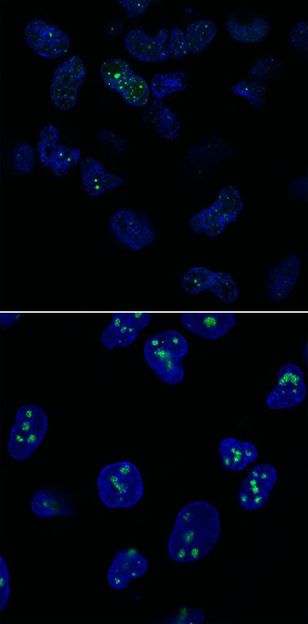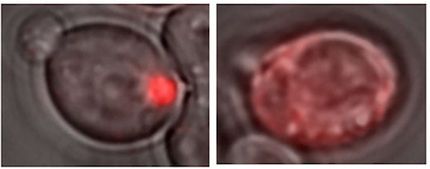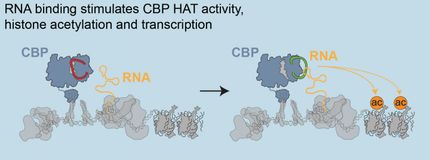Dampened mTOR signaling with the developmental disorder Roberts syndrome
Children born with developmental disorders called cohesinopathies can suffer severe consequences, including intellectual disabilities, limb shortening, craniofacial anomalies, and slowed growth. Researchers know which mutations underlie some cohesinopathies, but have developed little understanding of the downstream signals that are disrupted in these conditions.

Top: Skin cells from patients with Roberts syndrome display defects in the organization of nucleoli, specialized nuclear subdomains dedicated to the production of ribosomes (shown in green). Bottom: Normal cells. DNA is shown in blue.
Courtesy of Dr. Baoshan Xu, Stowers Institute for Medical Research
In a study published in PLoS Genetics, researchers at the Stowers Institute for Medical Research report that a prominent signaling pathway that drives cell growth is inhibited in the cohesinopathy known as Roberts syndrome (RBS). That work, which analyzes patient cells and zebrafish models of RBS, shows that jump-starting the sluggish signaling pathway with the amino acid L-leucine partially rescues defects associated with the disease at both the cellular and organismal level.
Cohesinopathies result from mutations in genes encoding cohesins and the factors that regulate their function. Cohesins form ring-shaped protein complexes that help organize the genome. RBS is caused by inactivation of the human gene ESCO2, which encodes an enzyme that chemically modifies cohesin.
In 2009, the team led by Stowers Investigator Jennifer Gerton, Ph.D., reported that the yeast homolog of ESCO2 plays an important role in the formation of the nucleolus, a special part of the nucleus devoted to the production of ribosomes. Ribosomes, large molecular factories made of RNA and protein, synthesize new proteins according to the instructions carried in messenger RNA.
Gerton suspected that nucleolar organization might be an evolutionarily conserved function for cohesins and wondered whether cultured skin cells derived from an RBS patients would display the same nucleolar defects she had observed earlier in baker's yeast bearing a mutation in the homologous gene.
Baoshan Xu, Ph.D, a postdoctoral researcher in the Gerton lab and the current paper's first author, observed that RBS cells grew slowly and were more likely to die than normal cells. Similar to the scenario in baker's yeast, they also exhibited aberrations directly pointing to ribosome malfunction. Most importantly, mutant cells showed biochemical changes in cell growth pathways. "One was upregulation of the activity of p53, a protein that senses ribosome defects," explains Xu. "And the other was strong inhibition of mTOR, a master signaling protein that stimulates ribosome production and as a result protein synthesis."
Since the mTOR pathway can be activated with L-leucine, Xu asked whether leucine would be able to stimulate the sluggish mTOR pathway in RBS cells and ameliorate the associated cellular defects. Remarkably, L-leucine treatment "rescued" some RBS cell defects including protein synthesis and cell growth.
To examine these outcomes in a living animal, Xu then analyzed zebrafish embryos carrying inactived ESCO2. These fish exhibit several properties of human RBS, including underdeveloped cranial features and slow growth. Supplementing L-leucine stimulated the mTOR pathways in RBS zebrafish and resulted in better growth and development.
Gerton is encouraged but cautious about these findings. "Use of a non-toxic, inexpensive amino acid to treat human disease could be of benefit," she says, noting that L-leucine dietary supplementation is being tested in clinical trials for Diamond Blackfan anemia, a genetic disorder. "Leucine supplementation might improve some disease manifestations in RBS, but many aspects of RBS are unlikely to respond to post-natal leucine treatment."
RBS is a rare cohesinopathy, but a related condition called Cornelia de Lange syndrome (CdLS) occurs more frequently—about 1 in 10,000 live births. Researchers have defined mutations causing CdLS, and CdLS zebrafish models are also available. In fact, Gerton recently received a grant from the Cornelia de Lange Syndrome Foundation to assess the effect of L-leucine supplementation in those fish.
Gerton says this work serves as an example of how understanding basic biology can contribute to understanding human disease. "It was only by recognizing the nucleolar defect in baker's yeast that we suspected the involvement of the mTOR pathway and the potential benefit of L-leucine for RBS." The mTOR pathway is also affected in other human diseases, and the effect of L-leucine needs to be tested for those diseases. "Both RBS and CdLS are caused by mutations that affect cohesin, although the molecular basis of CdLS is less well understood," she says. "A logical next step is to determine whether our work on RBS has any relationship to CdLS."






















































